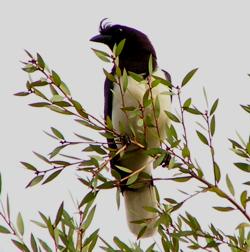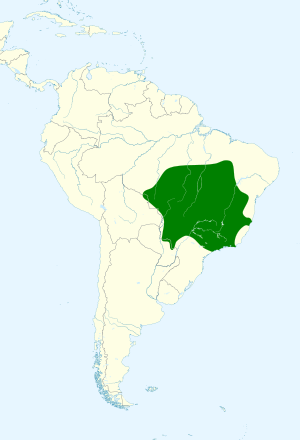Curl-crested jay facts for kids
Quick facts for kids Curl-crested jay |
|
|---|---|
 |
|
| Male | |
| Conservation status | |
| Scientific classification | |
| Genus: |
Cyanocorax
|
| Species: |
cristatellus
|
 |
|
The curl-crested jay (Cyanocorax cristatellus) is a beautiful bird found in South America. It's a type of jay, known for its unique look.
This jay is quite large, growing to about 35 centimeters (14 inches) long. It has a dark blue back and an almost black head and neck. Its chest and belly are bright white. A special feature is its curled crest of feathers, which rises from behind its beak. Males usually have a slightly larger crest, but both male and female jays look very similar.
Contents
What Does It Sound Like?
The curl-crested jay has a loud call. It sounds like "gray, graa, gray-gray-gray." Sometimes, they repeat this call many times. Their voice is similar to that of a crow.
Where Do They Live?
Curl-crested jays live in the cerrado and caatinga regions of central and northeastern Brazil. The cerrado is a type of savanna, and the caatinga is a dry forest. You can also find them in parts of the Amazon Basin and in northern Paraguay.
They prefer areas with suitable habitat. Where the environment is right, these jays are not rare. For example, they are the most common corvid (a bird type that includes jays and crows) seen in the Serra do Cipó National Park.
How Do They Live and What Do They Eat?
Curl-crested jays live in groups. These groups usually have 6 to 12 birds. They move together during the day, searching for food. One bird often acts as a lookout, watching for any danger.
These jays eat almost anything. They are known as "generalists." Their diet includes insects, spiders, and small animals like geckos. They also eat the eggs and young of other birds. They enjoy palm nuts and are especially fond of seeds from the Inga laurina tree. They also like fruits from the umbrella tree (Heptapleurum actinophyllum).
Sometimes, these jays even visit pequi trees (Caryocar brasiliense) in the morning. They feed on nectar from the flowers. They might also eat small invertebrates that visit these flowers.
Are They in Danger?
The IUCN (International Union for Conservation of Nature) does not consider the curl-crested jay a threatened species. In fact, their numbers are growing, and they are expanding into new areas. However, sometimes these expansions are temporary. Populations might disappear from places they once lived.
See also
 In Spanish: Urraca de cresta rizada para niños
In Spanish: Urraca de cresta rizada para niños



